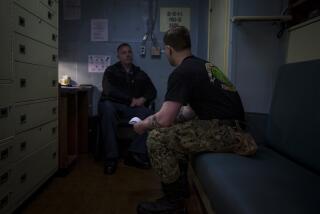Women, subs and nuclear radiation
- Share via
Should women sailors be allowed on submarines? The United States is poised to repeal the ban, and the first women are scheduled to serve aboard subs by 2012. But we must ask some serious questions before changing the policy.
During the Cold War, long before becoming a doctor, I served as a nuclear reactor operator aboard a fast-attack submarine. During that time, I often considered the thought of women as fellow crew members. There was never any question in my mind that women would be as capable as men. The issues of limited space and the need for separate quarters could be easily resolved by a visit to any of the unisex bathrooms found on our college campuses. Furthermore, U.S. submarines already have separate sleeping spaces for chief petty officers and for commissioned officers; partitioning another area for women would be easy. Finally, there is ample precedence for both sexes living together in prolonged isolation and close confinement — on the International Space Station, for example, and in Operation Deep Freeze in Antarctica.
So why would I see any problem with allowing women aboard submarines?
It is the matter of exposure to radiation that is most unsettling to me. It is the genetically sensitive tissue in women that is intimately involved in the process of childbearing that needs to be addressed, researched and commented on by our Navy’s leaders before they change the policy.
While sperm from men are frequently changing and thereby present a reduced vulnerability to radiation consequences, women have ovaries that contain radiation-sensitive tissue fixed for the life of the woman. Damage to the egg cells remains with the woman until that egg produces a baby. An even greater concern is that women who (by design or by accident) become pregnant would then possess the most radiation-sensitive tissue known: a developing fetus with a small number of cells that are rapidly dividing and thus vastly more sensitive to radiation.
It is widely believed by many that advanced shielding systems can adequately protect personnel from radiation and minimize the risk to women. This may be the case, perhaps, for larger ships, where increased distance of personnel from reactors can be protective. But on submarines, the nuclear reactor is near the center of the vessel, and sailors need to pass by that radiation-emitting system to get to the engine room watch stations, often several times a day. If a female sailor must stand watch, she will have to pass near the reactor four to six times a day, resulting in exposing a potential fetus to increased neutron and gamma energy as many as 350 to 400 times during a two-month patrol.
Of further significance is the kind of radiation the reactor is emitting; not just gamma energy, like chest X-rays or mammograms. A nuclear reactor generates gamma energy, slow neutron energy (creating five times more tissue damage than gamma energy) and fast neutron energy (creating 10 times more tissue damage), as well as other types of less consequence. My former engineering officer recently informed me that he had absorbed about 5,000 millirems during his time aboard our submarine.
In civilian life, a pregnant woman must first don a lead shield to protect her unborn baby before she has a chest X-ray (delivering about 10 millirems of gamma energy) or for a mammogram (70 millirems of gamma energy). But lead shields on submarines do not entirely protect personnel from the far more damaging neutron energy. Although the neutron shield system used helps reduce exposure, it is impossible to eliminate all neutron energy from reaching crew members. If a female submariner became pregnant just before deployment, the first weeks at sea could expose a tiny, radiation-sensitive fetus to significant radiation during a time when the fetus is at highest risk and before the woman may even know she’s pregnant.
How much radiation does it take to cause harm to fetal tissue? We really don’t know. Any radiation is harmful to dividing cells, but detectable damage is much harder to determine. We know that fetal doses between 1,000 millirems and 10,000 millirems create a “low” level of congenital malformations, mental retardation, uterine growth retardation or childhood cancer. Is “low” acceptable? Is “low” reassuring if a future baby is not perfect? Would “low” absolve the government and taxpayers from liability?
I call on all those who are working to change this policy to publicly address these questions before introducing women into the nuclear submarine environment:
•How much radiation would women be allowed to absorb before removing them from the nuclear environment?
•How many back-up nuclear watch standers will need to be available to replace women who have received excessive radiation, and how will this action affect the mission in enemy territory?
•What screening will be initiated on the day of departure to guarantee that the submarine is not heading out with a pregnant sailor aboard?
•What plans need to be established to remove a female sailor from the submarine, should she become pregnant during the deployment?
•What are the maximum levels of accumulated radiation acceptable to the ovaries of non-pregnant sailors who might be planning a family in the future, and at what point would a woman need to be removed if those levels were exceeded?
The public deserves answers to these questions, and female sailors volunteering for service aboard a nuclear submarine must be better informed about their risk before it is too late for them, or for the children they hope to bear.
Roger C. Dunham, a doctor of internal medicine, is the author of “Spy Sub: A Top-Secret Mission to the Bottom of the Pacific.”
More to Read
Sign up for Essential California
The most important California stories and recommendations in your inbox every morning.
You may occasionally receive promotional content from the Los Angeles Times.










